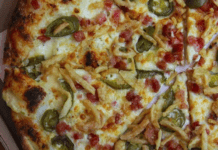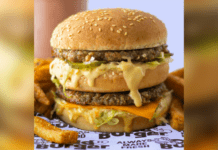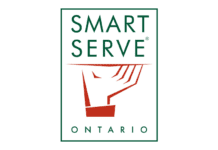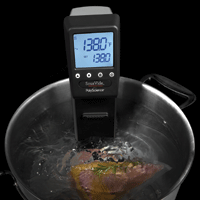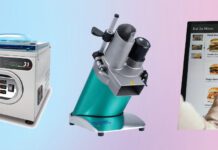Top chefs Gushue and Lepine explain how it takes the right equipment and know-how to successfully execute sous vide
You could say the sous-vide cooking technique — whereby food is cooked in a vacuum-sealed plastic bag at low temperatures for extended periods — has been slowly simmering in the North American lexicon for nearly 30 years. Having taken hold in Europe years ago, it only earned true acceptance in North American restaurants in the past decade.
Those chefs who have embraced sous-vide cooking will tell you it takes time and a lengthy learning curve for those who haven’t done their homework. For those who don’t understand the sous-vide cooking drill — or know the exact temperature needed — mistakes can be costly and food safety can be compromised.
The term sous vide has been misused over the years. While many think of it as the “boil-in-the-bag-dinner” type of cooking process, the term literally means “under-vacuum” and refers to the vacuum-sealing and compression process, not the water baths used to cook the sealed delectables.
Even manufacturers of sous-vide accoutrements are transitioning to the term “low-temperature cooking” to avoid confusion. They stress it’s not just the low temperature but the precision with which you regulate those temperatures, over hours of cooking time, that matter most. “With sous vide, it’s not so much about the equipment but how you approach it,” notes Christoph Milz, culinary channel manager for PolyScience in Niles, Ill. “The one big difference is the circulation. Some people will take a rice cooker, set it to 59[˚C] and call it sous vide. But it isn’t, because it’s a still water bath. The mixing of the water is very important to achieve a uniform temperature that is precise to within a tenth of a degree.”
For the uninitiated, the main types of equipment needed for sous vide cooking are vacuum sealers, thermal immersion circulators and water-bath chambers. Professional-grade circulators range from $800 to $1,200, while a good vacuum sealer can cost $2,500 or more.
For Filippo Mancuso, executive chef at Jump restaurant in Toronto, sous vide is about the vacuum sealer. His current model is a Turbovac from Nella. “As soon as I saw them in Europe, I had to get one,” he says. “Vacuum sealing is a great help when preparing and cooking food, because it keeps it longer for storage, your fridges stay cleaner and everything is controlled.”
Mancuso has since invested in two thermal circulators and Cambro bus pans (or water-bath containers) from PolyScience. He “loves” the circulators, because they keep the “temperature constant to within half a degree while circulating the water over the food.”
PolyScience circulators are considered the dominant player in North America, where the units were originally designed for use in research labs. “Later on they came out with new models that were better suited for foodservice, where more parts were encased in plastic and the heating coils weren’t so exposed,” Mancuso explains.
Marc Lepine, owner of Atelier Restaurant in Ottawa, has grown his collection of circulators to five, after having been introduced to sous-vide cooking at a competition in 2006. “I read everything I could and experimented a lot to get the precision I needed. We started with custards and ice-cream bases, moved on to meats, then seafood, to build up our repertoire one item at a time. We’re still learning a lot.”
Lepine uses a chamber vacuum sealer ($2,500) from Minipack. “We started with an external sealer but eventually saved up enough to get a chamber sealer. It’s far, far superior.” Sealers are not the place to cut costs, he warns. “Cheaper units don’t seal as well and won’t compress the food or let you set different pressure amounts. You don’t want delicate items breaking up when sealing.” He notes that circulators come in a variety of sizes based on volume needs. His current favourite is the PolyScience Professional Chef unit that he takes with him to culinary contests. “I love the portability. You can hook the circulator onto anything, and it does the job.”
When you get to the point where you can master sous vide, Jonathan Gushue, executive chef at Langdon Hall, says the creative possibilities multiply. “When I started it was all about vacuum sealing. It never entered my mind to cook with it. Even putting raw vegetables and fruit under pressure can make them more intense, meaty and brighter in colour.”
The cooking process also improves yield and saves costs. Gushue estimates that, with sous vide, he has cut the amount of stock he uses for braising by two-thirds, as well as reduced duck fat by more than three-quarters since duck breasts will render their own fat in process.
For his vacuum sealers, Gushue rents units from Nella that can seal externally and internally. (External sealing does not perform the vacuum function but is used for sealing items in a liquid with a weight equal to or greater than the product). As part of the rental agreement, they’re replaced approximately every six to eight months. He also has seven thermal circulators, including the new PolyScience Pro Series units that he says are more streamlined and have fewer areas to interrupt the water flow.
Sous vide forces you to be more precise and understand what you are doing and why, says Gushue. More importantly, it demands you keep your eye on the ball from a scheduling standpoint. “You have to be terribly organized, because you can’t bang off an item in six hours — it could take 72. It’s funny when I hear people asking when the lamb shoulder will be ready and the answer is 7 p.m. tomorrow. But the end results are amazing, the yield is far better, and the food keeps its integrity for presentation,” says the toque. It may take time and effort, but once you master the nuances of sous-vide cooking, “It can open up a whole new world.”
Keep Reading
Keeping Cool: The Latest in Refrigeration and Ice Making
In the Works: Profiling the Expanding Burger Chain
Let’s Do Lunch: Building Midday Business

